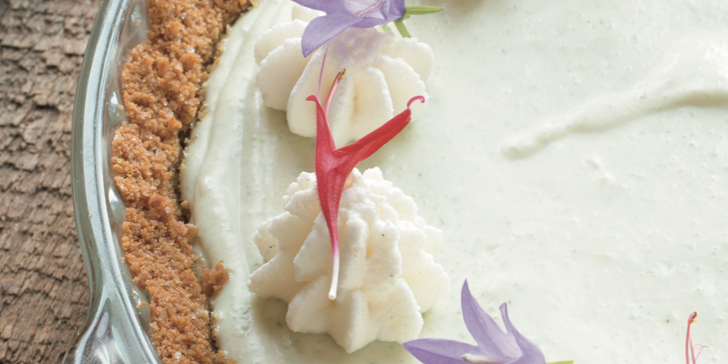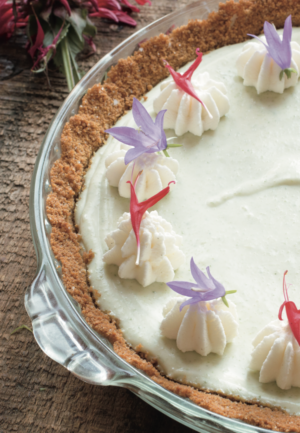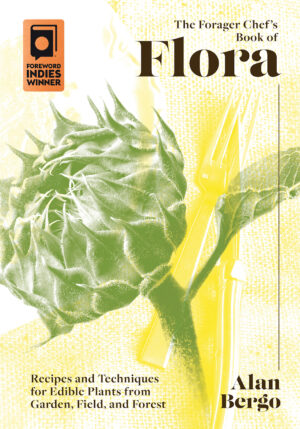Spruce Tip Key Lime Pie: A Flavorful, Foraged Dessert

Nothing is quite as sweet as baking a dessert with ingredients you foraged for yourself. This spruce tip key lime pie recipe is simple, delicious, and sure to impress all your guests this winter.
The following is an excerpt from The Forager Chef’s Book of Flora by Alan Bergo. It has been adapted for the web.
RECIPE: Spruce Tip Key Lime Pie
Makes one 91/2- or 10-inch (26 cm) pie
This recipe offers another fun way to showcase the affinity spruce tips have with citrus.
This is a little different from traditional key lime pie, as it won’t be as tart, but it’s close, and the spruce flavor works really well with a simple graham cracker crust. Serve with stewed blueberries or your favorite fruit, and whipped cream.
Ingredients
Walnut Graham Crust
- 1/4 teaspoon salt
- 1/4 cup (150 g) sugar
- 1 1/4 cups (135 g) graham cracker crumbs
- 1/4 cup (30 g) finely chopped black walnuts or regular walnuts
- 1/4 teaspoon ground cinnamon
- 6 tablespoons unsalted butter
Filling
- 4 sheets silver gelatin, or 1 1/4 ounces (35 g) unflavored gelatin
- 2 cups (480 ml) heavy cream
- 1 can (14 ounces/397 g) sweetened condensed milk
- 1/4 teaspoon salt
- 1/3 cup (65 g) sugar
- Scant 1/2 cup (28 g) chopped fresh or frozen spruce tips, any papery husks removed
- A few generous scrapes of fresh lime zest, to taste
- 1/3 cup (80 ml) key lime juice or Persian lime juice

Process
Preheat the oven to 350°F (180°C). Place all the crust ingredients except the butter into the bowl of a food processor and pulse until mixed.
Melt the butter and pour it slowly into the food processor, pulsing just until the crumbs are evenly moistened and begin to stick together. Press the mixture into the pie pan, extending the crust up the sides.
Bake the crust for 12 to 15 minutes or until lightly browned. Allow the crust to cool while you prepare the filling.
Soak the gelatin sheets in ice water, then squeeze them dry. Warm half of the cream with the condensed milk in a saucepan, then add the gelatin and whisk thoroughly until just dissolved (you’ll want to purée it with a hand blender if you use powdered gelatin).
Remove the saucepan from the heat and add the remaining cream, salt, and sugar. Set the saucepan in a sink or bowl full of cold water and whisk the mixture until it reaches room temperature.
Pour the mixture into a blender, add the spruce tips, and purée for 30 seconds or so until well blended, then strain through the finest strainer you have. Whisk the lime zest and juice into the mixture well, which will cause the filling to thicken, then pour it into the crust and refrigerate until set, a few hours.
Recommended Reads
Recent Articles
Chances are, you’ve seen cattails growing on the edge of your local lake or stream at least once or twice. Instead of just passing these plants, try foraging for and cooking them to create delicious seasonal dishes! The following excerpt is from The New Wildcrafted Cuisine by Pascal Baudar. It has been adapted for the…
Read MoreGarlic mustard: while known as “invasive,” this plant can be consumed in its entirety and has great nutritional value. Plus, the garlic-flavor is a perfect addition to any recipe that calls for mustard! The following are excerpts from Beyond the War on Invasive Species by Tao Orion and The Wild Wisdom of Weeds by Katrina…
Read MoreOh, honeysuckle…how we love thee. If only there was a way to capture the sweet essence of this plant so we could enjoy it more than just in passing. Luckily, foraging and some preparation can help make that happen! Here’s a springtime recipe that tastes exactly like honeysuckle smells. The following excerpt is from Forage,…
Read MoreIntroducing…your new favorite brunch dish! This whole broccoli frittata is packed with fresh, wildcrafted flavors that are bound to help you start your day off on the right foot. The following is an excerpt from The Forager Chef’s Book of Flora by Alan Bergo. It has been adapted for the web. RECIPE: Whole Broccoli Frittata…
Read MoreWondering where to forage for greens this spring? Look no further than hedges, which serve as natural havens for wild greens and herbs! The following is an excerpt from Hedgelands by Christopher Hart. It has been adapted for the web. Food from Hedges: Salads and Greens Let’s start by looking at all the wild foods…
Read More






